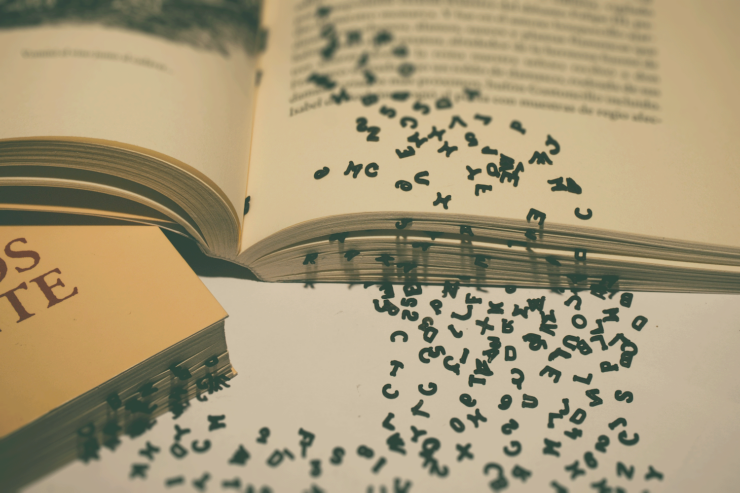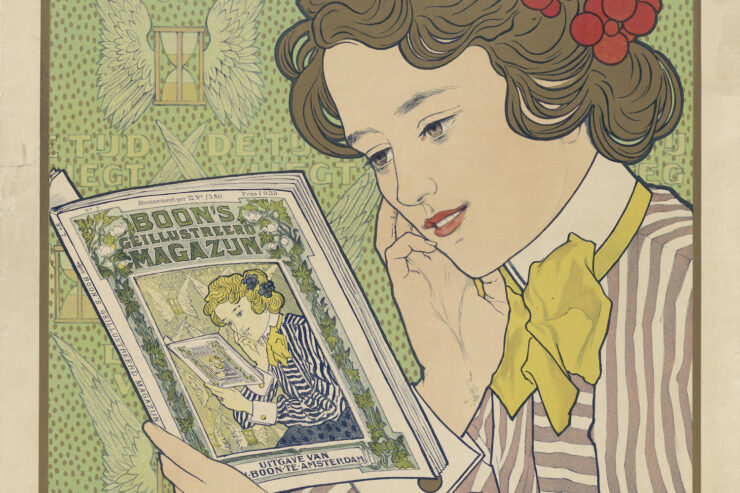For some of us readers, this is Kelly Link Week. The publication of her new collection, White Cat, Black Dog, is cause for great celebration. That celebration began earlier this month with a profile in Vulture that included endearing details such as the names of Link’s chickens and a short history of her publishing career.
But what I got stuck on—hung up on, in the most enjoyable way—is a bit about stories and novels. “The novel hardens as you go on,” she says to the interviewer. “At a certain point the ambitions, even the shape, begin to feel inevitable. The short story stays fluid.”
Link is talking about writing, but my reading brain bit down on this and wouldn’t let go. What does inevitability—hardness—feel like in a novel, and where does fluidity lie? Can a novel stay fluid? And how do genre and style play into it?
This is all very subjective and maybe slightly esoteric as a result; my fluid novel won’t necessarily be yours, not any more than a story that feels inevitable to you is necessarily the same for me. As readers, these things are, at least in part, products of what we bring to the page. I’ve read plenty of books that felt inevitable simply because of the sheer number of stories I’d already read in the same vein (YA dystopias of the 2000s, I am looking at you). But I like to think that every one of those books was also discovered by a reader who had never seen anything like it.
Some stories are meant to feel inevitable—that isn’t a bad thing. There’s the sense that it couldn’t possibly have turned out any other way; the sense of dread as you feel a tragic ending approaching; the sense of clockwork in a taut thriller, of carefully plotted strands in a story about prophecy. That kind of narrative inevitability can be fascinating, compelling, propulsive. I read most of the Expanse novels in huge gulps because once the pieces start moving, they slide you right into a narrative that pulls. It’s a narrative rich with character, and world-building, and scale and hope. But I don’t know that I would call it fluid. It knows where the edges are and fills them in brilliantly.
What I think of, when I think of the idea of fluidity and stories, is an unwillingness to be pinned down. An elusiveness. You can’t attach a tidy moral to a fluid story, or easily sum up what it was “about.” What you take away from it is likely more image, feeling, exchange than plot or drama, though those may be present.
For me, fluidness has to leave something unsaid, undefined, un-detailed. The worldbuilding is atmospheric, not precise. A fluid story does not, I think, come with a map. (Unless it’s a very peculiar map, like the ones in Catherynne M. Valente’s Palimpsest.) Fluidness in a novel looks, maybe, like the work of Helen Oyeyemi, like the not-quite-fairytales she spins in Gingerbread and Boy, Snow, Bird, like the house in White is for Witching, which I remember entirely as an atmosphere—one I both long to revisit and feel inexplicably anxious about.
There are stories that call for fluidness and stories that don’t, the same way there are stories that call for different settings, different styles, different vibes. An interesting flurry of things have been said this week about style and its place in the literary landscape—people discussing a frequent question about whether some writers are just better at plot and some better at style; whether “invisible prose” exists; whether there are two kinds of readers, each wanting one thing or the other, style or story, or some other binary that is only one axis along which we read.
Do any readers really only ever want one thing? Does any book really only do one thing? Does style belong in SFF? And what does that question really mean?
To some degree I’m with Lincoln Michel, whose piece on “invisible prose” I linked above; I don’t really think any prose is invisible. Still, I also understand what readers mean when they say that: They mean the words are under the story, for lack of a better way to put it. You notice what’s happening, rather than how the author describes it happening. Michel’s point is that a story is its prose; you can’t take them apart. But I like Max Gladstone’s way of putting it; he proposes an “additional tension: between texture and aerodynamics.”
This clicked immediately into my brain—yes, exactly. A texture you slow down to consider and feel, or an aerodynamic style (but it is a style!) that keeps you moving smoothly along. One is not without the qualities of the other, but the ratio changes. The ratio changes in everything, book to book, even page to page.
Fluidity has texture. Fluidity makes you stop and feel the edges, the seams, the velvet underpinnings and the granite backdrops. And I think my colleague Christina Orlando got at something about fluidity and hardness when they tweeted:
this is maybe controversial but theres a BIG divide in genre fiction particularly between plot-forward writing and prose-forward writing. most sff readers prefer the former, most top sff writers are the former. lyrical sff is often called literary. there are few who can do both https://t.co/jXsgKMkGL7
— christina orlando
(@cxorlando) March 24, 2023
The most nail-on-the-head part of this observation, to me, is the bit about how the prose-forward SFF writers are often considered literary, or elevated, in a different way. Why do some clearly speculative stories get published by literary imprints, shelved in general fiction, treated as if they are not SFF stories at all? It’s not always because they are prose-forward, but it’s part of it. Kelly Link’s gorgeous stories belong to SFF readers, but they belong to general readers, too; her books aren’t always in the SFF section, and her last collection, Get in Trouble, was a finalist for a Pulitzer Prize. Karen Russell’s Swamplandia and Eowyn Ivey’s The Snow Child were also Pulitzer finalists; both, I think, could be called fluid—and be claimed by speculative readers as well as the mainstream.
Boundaries are porous things. (Where do we put Victor LaValle’s The Changeling? The recent novels of Emily St. John Mandel?) None of this is writ in stone; very few writers do just one thing. But there is something in here about how books are received, if not written—about what different readers want and how those desires are regarded; about what is viewed as “good” writing and what people take for granted; and about how writers are somehow shelved into sections or classifications that don’t suit them.
I think what I want from all of this is more fluidity across the board—more lyrical SFF novels, more willingness to ignore the lines, erase the maps, step off the edges of the known world. Can we be more fluid readers? What does that look like?
Molly Templeton lives and writes in Oregon, and spends as much time as possible in the woods. Sometimes she talks about books on Twitter.















I think that short stories are allowed to be far more intense than novels. They’re like sprints and the brevity and focus can allow for more strangeness and play than in a novel, which is obviously a marathon. Not that marathons are bad, but you can’t go all out from the starting line or else you’re going to lose steam on mile 13. A novel needs to bring the reader along as it’s running buddy. A short story can have the reader in the stands admiring the sprinter. All the action is right there.
More lyrical SFF novels – yes please!! I believe there’s some not insignificant overlap between those who enjoy literary fiction and those who enjoy SFF. Recently with my (non-SFF!!) book club we’ve been enjoying works from the likes of Wilde, Steinbeck, etc. But also just read Ishiguro’s “Klara and the Sun” which is a lovely near-SF piece of literary fiction. It can be done. St. John Mandel is another good example. There is a place for good plot-heavy SFF (Sanderson’s prose is artless, but he knows how to crank out the plot!) and I believe there’s also a place for more dreamy and lyrical SFF. I love when I find such.
As readers, we are sometimes in different reading “moods”. Sometimes I want the sugary rush of a Sanderson novel. Sometimes I desire the delicate intricacies of an Iain Pears or a Susanna Clarke (or even a Le Guin!). I confess I generally am more style-forward than plot-forward, which puts me in the minority I fear. Still, I think this is a worthwhile discussion to have, and to ourselves seek out books that are more atmosphere than story, those that are hazy and won’t answer all the questions but instead will create a space in which we dream and even dance.
This is one of those conversations I often find perplexing as much as I find it intriguing. This preoccupation between substance and style can be traced all the way back (in English language fiction) to William Blake, a devotee of what was then called Romanticism, and perhaps even further! What I find incredible about SFF is its capacity to hold the extraordinary plays of William Shakespeare (his speculative plays are among his best, IMO), medieval epics such as Beowulf, The Faerie Queen, and a slew of Arthuriana, the transcendent beauty of Tolkien’s Middle-Earth books, as well as Lovecraft’s sloppy prose, Sanderson’s simple yet effective sentences, and a whole network of writers working between those two poles. To say nothing of legends and fairy tales written and re-written and collected and re-purposed and reiterated!
That particular value is something I’ve learned to treasure, and so I find utter delight in so much more of the field, because I understand that every author aims towards different goals–and I’m interested in the discovery and study of as much of it as possible.
I’m about 3/4 of the way through Dhalgren by Chip Delaney and I think it’s a perfect fit into the fluid category that this article is getting at. Heady prose, sudden perspective shifts, beautifully lyrical writing. It would be hard to say what the book is “about”, precisely, but it does an incredible job of impressing emotions on you as you read.
I’m a reader who tends to value style above other qualities. I remember after reading Blood Meridian I was floored by the texture of the book and the way McCarthy wove in epiphanies and insights in a way that really smacked you in the face. I recommended it to someone else and their response was mostly that they were repulsed by the content of the narrative (which is indeed very violent and bleak). Focusing more on narrative versus focusing on style and aesthetics are equally valid viewpoints, I think, and it’s good that we have readers and writers who do both.
A couple of other great aesthetic-forward writers who fall under the speculative/weird fiction umbrella are Yoko Ogawa (horror) and China Miéville (scifi/fantasy).
Hi, Bookseller here!
There are two aspects that I think are missing. The first of which is that readers of mainstream fiction WILL NOT step foot in SFF territory. They think of SFF as terrible writing, pow pow bang bang spaceships and bikini clad wimmins, a hangover from the years of pulp and, well, bad cover artwork. Quality of writing is seen as rare and special and deserving of a wider audience of people who “read good books”.
With the popularity of ST:TNG and other TV media through the 80s and 90s, that media became of the face of SFF, and then once the Marvel movies came along…that was all she wrote. Not only the prevalence of Urban Fantasy also brought many books onto the regular fiction shelves as that is, I personally think, the love child of Romance and SFF. Not SFF enough, but also too much Romance for many SFF readers*.
The funny thing is that there’s currently heaps of straight up SFF that’s made it’s way into the regular fiction sections, it’s just called ‘Speculative Fiction’ and usually imports into the inventory from the wholesalers as ‘fiction’. Speaking for myself, where that book goes Very Much depends on where I think it will sell from. For example, Ministry of Future was a good seller from the SFF section, but it took. off. when we put it with the non-genre fiction display. My boss, who had always disparaged SFF, is now reading Climate Fiction like no one’s business and loving it.
The second aspect is that non-genre fiction also has plenty of non-fluid novels, they’re just labeled “women’s fiction” or “beach reads” and tend not to be written by people with MFAs.
Sometimes people just want to read a good story. We all love it when a good story has deeper meaning beyond the words on the page, but to consider good stories less than “elevated fiction” is, I think, a poor service to the audience. It’s possible to be both, it’s just that a good portion of the critics (profession and armchair) aren’t interested in doing that deep dive. Just my opinion, and not a criticism of any of the authors mentioned in this article.
I hope this comment makes sense, because I’m writing while at work and getting interrupted by phones and customers and UPS, so, yanno. Thanks for listening to me rant!
*All hail the new SFF Romance imprint!